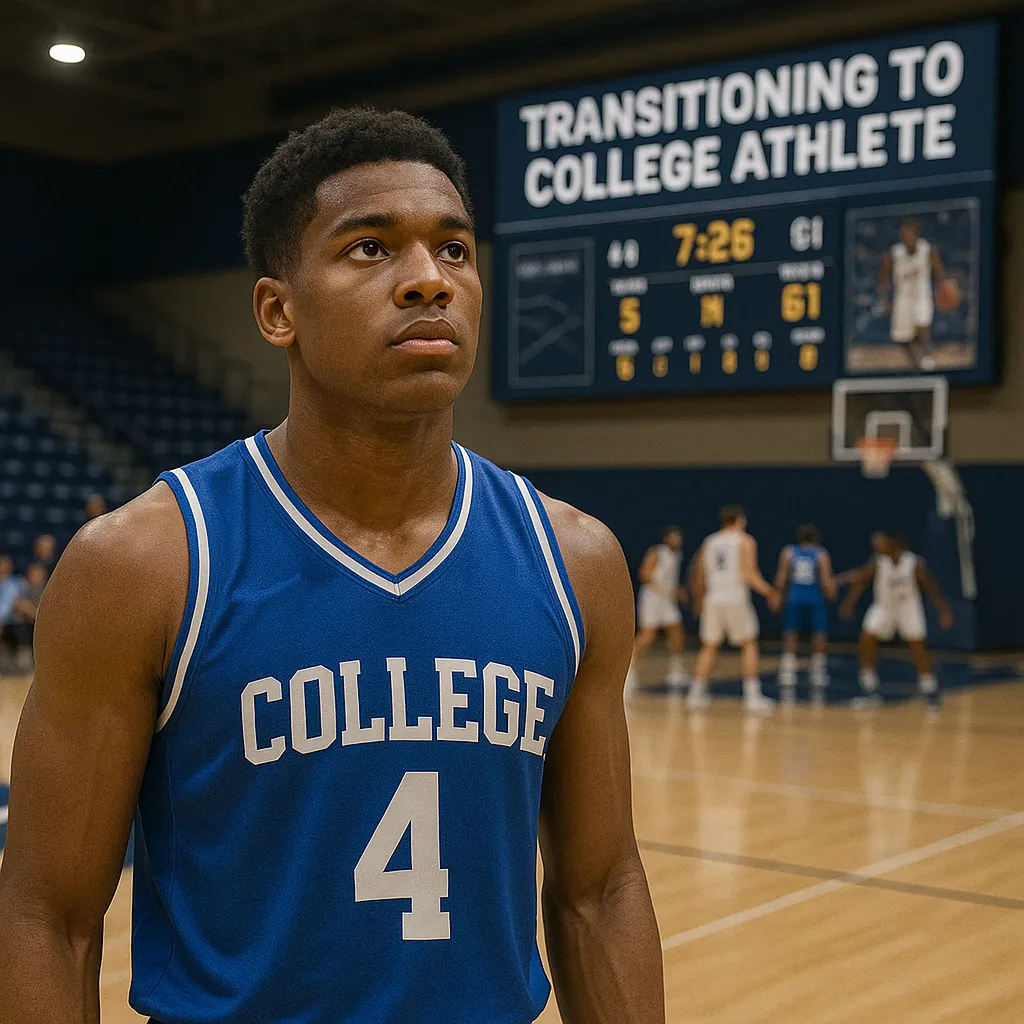
How To Navigate The Recruiting Maze: Phase 4: Transition – Prepare to Compete at the Next Level
How To Navigate The Recruiting Maze And Prepare For The Next Level
Every athlete chasing a college dream faces a crossroads during the recruiting journey. Transitioning to compete at the next level does not happen overnight. Phase 4 of recruiting, called Transition, demands more than raw talent. Athletes must shift their mindset, build professional habits, and own their next steps. Coaches expect more than highlight reels or stats. They look for competitors equipped to thrive in new environments. This phase separates those who merely arrive from those who make an impact. Here is how to prepare for that leap, outsmart the recruiting maze, and forge a path that stands out in a crowded field.
Understanding Phase 4: The Reality Of Transition
Transition marks the shift from prospect to competitor. At this stage, recruits step beyond offers and campus visits. They enter a space where preparation meets execution. Athletes no longer focus on getting noticed. Instead, they must prove they can handle the grind and pressure of college sports. Coaches assess whether a recruit can adapt to new systems, manage academic demands, and fit into established team cultures. This phase tests self-discipline, emotional resilience, and a willingness to learn fast.
Many athletes underestimate the shock of this transition. High school accolades do not guarantee college success. The speed and physicality of the next level often catch newcomers off guard. Athletes who excel in this phase recognize gaps in their game, embrace feedback, and put in targeted work. They build routines that balance training, recovery, and academics. Preparation for this phase often determines how quickly a recruit earns trust and playing time.
Family, mentors, and coaches play pivotal roles during transition. Their support helps athletes navigate unfamiliar territory and avoid common pitfalls. Open communication is crucial. Athletes should not hesitate to ask questions and seek guidance. The most successful transitions happen when athletes approach this stage with humility and a relentless work ethic.
Building A Next-Level Mindset
Mindset drives performance at every stage, but it becomes the engine during transition. Athletes who thrive at the next level train their minds as deliberately as their bodies. Complacency rarely survives in a college locker room. Recruits must replace comfort with curiosity and adopt a growth mindset. Mistakes become learning opportunities, not setbacks. Feedback is a tool for improvement, not criticism to fear.
Developing this mindset requires honest self-reflection. Athletes should assess their strengths, but also confront weaknesses head-on. Visualization, goal setting, and journaling can anchor focus. Athletes who set process-oriented goals, such as improving a specific skill or building a new habit, tend to progress faster than those who chase only outcomes. Mental skills coaches and sports psychologists often help recruits reframe pressure and perform under stress.
Confidence grows through preparation, not bravado. Athletes who show up early, ask questions, and engage fully in team meetings send a strong signal to coaches. They become known as competitors who want to get better, not just get by. This reputation often determines who sees the field, especially during the early months on campus.
Mastering The Physical Demands
College sports require a new level of physical preparation. Athletes who enter transition already embracing structured strength and conditioning programs gain a competitive edge. Off-season work becomes non-negotiable. Recruits should seek guidance from certified trainers or strength coaches to tailor programs that fit their sport and position.
Speed, agility, and endurance matter, but so does durability. The college schedule packs more games, tougher practices, and greater travel demands. Recovery routines with nutrition, sleep, hydration, and mobility work are as important as weight room numbers. Injuries can derail momentum fast. Athletes who prioritize injury prevention and listen to their bodies stay in the mix longer.
Many programs now offer performance testing during the summer or preseason. Athletes must be ready to perform on demand, not just during a highlight moment. Those who lag behind in conditioning or strength may find themselves watching from the sidelines. Preparation during transition is not optional. It is the price of admission to real competition.
Academic Preparation: Staying Eligible And Competitive
Academic eligibility rules do not bend for athletic potential. Every year, talented recruits falter due to missed credits, poor grades, or lack of time management. Athletes entering Phase 4 must know the academic requirements for their division whether NCAA, NAIA, or NJCAA. Early conversations with academic advisors prevent costly missteps.
Time management skills become a lifeline. College athletes juggle demanding practice schedules, travel, and coursework. Tools such as planners, digital calendars, and study groups help keep athletes organized and accountable. Seeking out tutoring or academic support early, not after grades slip, sets a tone of responsibility. Programs often monitor academic progress closely. Athletes who fall behind risk suspension or loss of scholarship.
Strong academic habits also help athletes stand out to coaches. Those who consistently attend class, participate, and show initiative in their studies build trust. Coaches want athletes who will not create headaches off the field. Academic strength signals maturity and readiness for the demands of college life.
Building Relationships With Coaches And Teammates
Every successful transition hinges on relationships. Coaches and teammates become a new support network. Athletes who invest in these relationships adapt faster and enjoy the process more. Clear, respectful communication signals maturity. Listening first, then speaking, carries weight in a new locker room.
Trust grows through reliability. Showing up on time, following through on commitments, and supporting teammates during tough moments all matter. Athletes should introduce themselves, ask about team traditions, and show genuine interest in others’ journeys. These small actions help recruits move from outsiders to valued members of the group.
Coaches appreciate athletes who are coachable. That means taking feedback seriously and applying it quickly. Defensive or argumentative responses rarely impress. Athletes who thank coaches for their guidance, even when it stings, build reputations as team-first competitors. These relationships often open doors to more playing time and leadership opportunities.
Leveraging Resources: Campus Support Systems
Colleges offer a wealth of support resources for student-athletes. Academic tutors, sports psychologists, nutritionists, and athletic trainers all stand ready to help. The best athletes use these resources proactively, not just in crisis. Early engagement with advisors and support staff creates a safety net before problems arise.
Mental health has become a major focus in college athletics. Stress, homesickness, and performance anxiety affect nearly every recruit during transition. Many athletic departments now provide confidential counseling services. Seeking help is a sign of strength, not weakness. Athletes who care for their mental well-being perform better and recover faster from setbacks.
Financial aid offices, career counselors, and alumni networks also offer valuable guidance. Athletes should take advantage of workshops, resume support, and networking events. Building these connections during transition sets the stage for success long after the season ends.
Common Pitfalls And How To Avoid Them
Transition exposes gaps in preparation quickly. Some of the most common pitfalls include:
Overestimating physical readiness and underestimating academic demands
Ignoring time management skills until schedules become overwhelming
Relying only on coaches for feedback, rather than seeking peer support
Failing to use campus resources or ask for help early
Letting ego or fear of failure block growth and adaptation
Athletes can avoid these traps by staying honest about their progress, building routines that prioritize both performance and recovery, and keeping communication channels open. Checking in regularly with mentors, parents, and advisors keeps small issues from becoming big setbacks. Staying humble and hungry keeps recruits moving forward, even when the learning curve feels steep.
Setting Goals For The Next Level
Goal setting transforms transition from survival mode to growth mode. The best goals are specific, measurable, and time-bound. Athletes should set goals in every area such as athletic, academic, and personal. Examples include improving a key skill by a set date, maintaining a certain GPA, or making a positive impact on team culture.
Sharing goals with coaches and mentors creates accountability. Regular progress reviews allow for adjustments and keep motivation high. Athletes who write down their goals and revisit them often stay focused, especially during setbacks or plateaus.
Celebrating small wins along the way fuels long-term progress. Every step forward, no matter how small, builds confidence and momentum. Goal setting during transition is not just about chasing awards. It is about building habits that prepare athletes for the next challenge and every one after that.
Action Steps To Stand Out During Transition
Standing out during transition takes more than talent or potential. Here are actionable steps every recruit should consider:
Arrive early for team meetings, workouts, and classes
Introduce yourself to coaches, teammates, and campus staff
Ask questions about expectations, team culture, and support resources
Track workouts, nutrition, and rest to monitor progress
Set daily, weekly, and monthly goals
Seek out older teammates or mentors for advice
Communicate openly with family and advisors about challenges
Take responsibility for mistakes and learn from feedback
Engage in community or campus events to build your network
Athletes who follow these steps not only survive transition, they thrive. Preparation, humility, and drive separate recruits who fade from those who become leaders at the next level.
The New Beginning: Owning The Next Level
Transition marks both an end and a beginning. The recruiting maze tests patience and persistence, but the next level demands something more profound, authentic ownership. Athletes who step onto campus ready to compete, learn, and connect find themselves shaping the culture they once hoped to join. Every challenge becomes a chance to build a legacy, not just a résumé. The journey never truly ends; it just evolves. The next level rewards those bold enough to prepare, adapt, and lead. Start strong, stay curious, and recognize that every step in the maze shapes the athlete you become.
Frequently Asked Questions
What is the most important skill to develop during the transition phase?
Adaptability stands out as the most critical skill. Athletes who adjust quickly to new demands whether physical, academic, or social, find success faster and enjoy their experience more.
How can athletes balance academics and athletics in college?
Time management is the key. Using planners, setting priorities, and seeking academic support early helps athletes keep up with classes and athletic commitments.
What resources should recruits use during the transition?
Academic advisors, athletic trainers, sports psychologists, and peer mentors all offer valuable support. Engaging with these resources early sets a strong foundation.
How do coaches evaluate new recruits during this phase?
Coaches look for coachability, work ethic, and ability to fit into team culture. Consistently showing effort, asking questions, and responding to feedback leaves a positive impression.
Where can athletes find more guidance on recruiting and transition?
Explore recruiting resources and stories from athletes who have navigated the process, such as this step-by-step guide or tips on maximizing your potential.
Are you feeling fully prepared for the shift in expectations at the next level?
What could go wrong if you step onto campus without understanding the demands of a college athlete?
What if your transition plan could give you a competitive edge before the season even starts?





